Abstract
Movie box-office research is an important work for the rapid development of the film industry, and it is also a challenging task. Our study focuses on finding the regular box-office revenue patterns. Clustering algorithm is unsupervised machine learning algorithm which classifies the data in the absence of early knowledge of the classes. Unlike static data, the time series data vary with time. The work focused on time series clustering analysis is relatively less than those focused on static data. In this paper, the sparse subspace clustering (SSC) algorithm is introduced to analyze the time series data. The SSC algorithm has a better performance both on the artificial data set and the daily box-office data than recently developed well-known clustering algorithm such as K-means and spectral clustering algorithm. On the artificial data set, SSC is more suitable for time series, whether from the angle of clustering error or visualization. On the actual data, movies are divided into five clusters by SSC algorithm, and each cluster represents a distinct type of distribution pattern. And these patterns can be used in movie recommendation, film evaluation and can guide theater exhibitors and distributors. In addition, this is the first time to apply SSC to deal with time series clustering problem and get a pleasant effect.






Similar content being viewed by others
References
Barry RL, Kohl LS (1989) Predicting financial success of motion pictures: the ‘80 s experience. J Media Econ 2(2):35–50
Sochay S (1994) Predicting the performance of motion pictures. J Media Econ 7(4):1–20
Park J, Chung Y, Cho Y (2015) Using the hierarchical linear model to forecast movie box-office performance. the effect of online word of mouth. Asia Pac J Inf Syst 25(3):563–578
Karniouchina EV (2010) Impact of star and movie buzz on motion picture distribution and box-office revenue. Int J Res Mark 28(1):62–74
Chakravarty A, Liu Y, Mazumdar T (2009) The differential effects of online word-of-mouth and critics’ reviews on pre-release movie evaluation. Soc Sci Electron Publ 24(24):185–197
Asur S, Huberman BA (2010) Predicting the future with social media. Proc of Wiiat 7(2):492–499
Koehler-Derrick G (2013) Quantifying anecdotes: google search data and political developments in Egypt. Ps Political Sci Politics 46(2):291–298
Wang X (2015) The brief introduction of the history of box-office research. Doctorate dissertation, Chongqing University
Jedidi K, Krider R, Weinberg C (1998) Clustering at the Movies. Market Lett 9(4):393–405
Li B, Lu F, Zhao X, Wang Q, Wang S (2010) Chinese movies’ life cycle model and empirical analysis. Syst Eng Theory Prac 30(10):1790–1797
Yahav Inbal (2016) Network analysis: understanding consumers’ choice in the film industry and predicting pre-released weekly box-office revenue. Appl Stoch Models Bus Ind 32(4):409–422
Lu Y et al (2013) Implementation of the fuzzy C-means clustering algorithm in meteorological data. Int J Database Theory Appl 6(6):1–18
Yang L et al (2015) A novel combination forecasting algorithm based on time series. Int J Database Theory Appl 8(2):157–170
Möller-Levet CS, Klawonn F, Cho KH, Wolkenhauer O (2003) Fuzzy clustering of short time-series and unevenly distributed sampling points. In: Berthold MR, Lenz HJ, Bradley E, Kruse R, Borgelt C (eds) Advances in intelligent data analysis V. IDA 2003. Lecture notes in computer science, vol 2810. Springer, Berlin, Heidelberg, pp 330–340
Elhamifar E, Vidal R (2013) Sparse subspace clustering: algorithm, theory, and applications. IEEE Trans Pattern Anal Mach Intell 35(11):2765–2781
Macqueen J (1967) Some methods for classification and analysis of multi variate observations. In: Proceedings of, Berkeley symposium on mathematical statistics and probability, pp 281–297
Zhang T, Chen L, Ma F (2014) An improved algorithm of rough K-means clustering based on variable weighted distance measure. Int J Database Theory Appl 7(6):163–174
Zhang Z, Wang C (2015) Research on the AE signal de-noising based on k-means clustering and the wavelet transform. Int J Multimed Ubiquitous Eng 10(7):223–228
von Luxburg U (2007) A tutorial on spectral clustering. Stat Comput 17:395–416
Bhissy KE, Faleet FE, Ashour W (2014) Spectral clustering using optimized Gaussian Kernel function. Int J Artif Intell Appl Smart Device 2(1):41–56
Malik J, Shi J (2000) Normalized cuts and image segmentation. IEEE Trans Pattern Anal Mach Intell 22(8):888–905
Vidal R (2011) Subspace Cluster Application in motion segmentation and face clustering. In: IEEE signal processing magazine 2011, March
Wang WW et al (2015) A survey on sparse subspace clustering. Zidonghua Xuebao/acta Automatica Sinica 41(8):1373–1384
Elhamifar E, Vidal R (2009) Sparse subspace clustering. In: IEEE conference on computer vision and pattern recognition, 2009, CVPR 2009. IEEE, pp 2790–2797
Li CG, Vidal R (2015) Structured sparse subspace clustering: a unified optimization framework. In: IEEE conference on computer vision and pattern recognition, pp 277–286
Acknowledgements
This paper is financially supported by the Fundamental Research Funds for the Central Universities, the Outstanding Young Teacher Training Project of Communication University of China (YXJS201527), Engineering Planning Project of Communication University of China (3132018XNG1823) and the Research of Key Technology in modeling digital movie service management intelligent data repository (2015-56).
Author information
Authors and Affiliations
Corresponding author
Ethics declarations
Conflict of interest
No conflict of this work and authors.
Rights and permissions
About this article
Cite this article
Wang, Y., Ru, Y. & Chai, J. Time series clustering based on sparse subspace clustering algorithm and its application to daily box-office data analysis. Neural Comput & Applic 31, 4809–4818 (2019). https://doi.org/10.1007/s00521-018-3731-7
Received:
Accepted:
Published:
Issue Date:
DOI: https://doi.org/10.1007/s00521-018-3731-7




